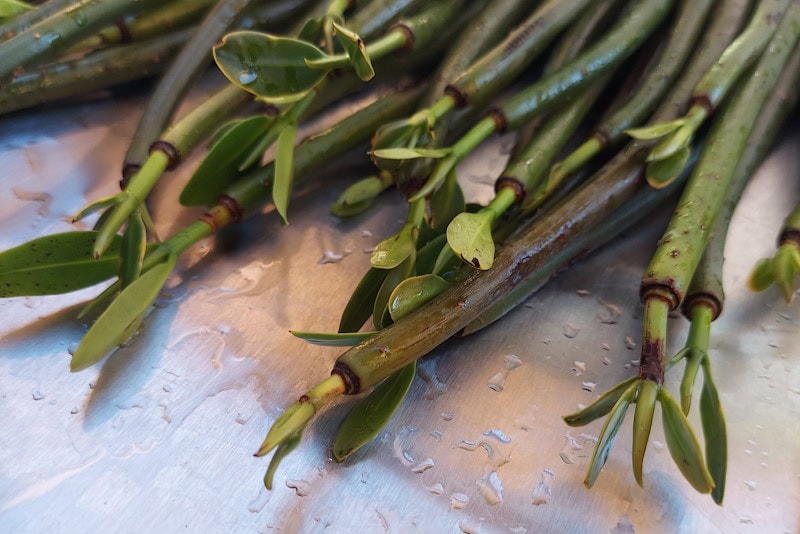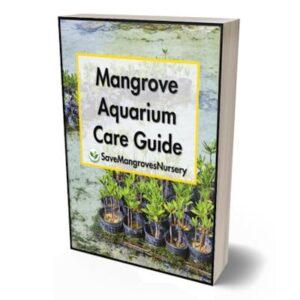
Adding Red Mangrove Plants to your aquarium can be incredibly rewarding. They bring a unique beauty and contribute to a healthier aquatic environment. However, like any living thing, they need the right care to thrive.
If you’re a proud owner of one of these fascinating plants, it’s essential to recognize the early warning signs that your mangrove might be in trouble. Let’s dive into these signs and how you can address them.
1. Yellowing Leaves
Yellowing leaves are often the first indication that your mangrove plant isn’t happy. When I first started growing mangroves with my daughter, I noticed this issue and panicked a little. But after some research and trial and error, we figured out that it was mostly related to nutrient deficiencies.
Good vs Bad
✔️ Good: Healthy mangrove leaves are vibrant green, indicating they are absorbing nutrients and photosynthesizing efficiently.
❌ Bad: Yellowing can signal a lack of essential nutrients, such as iron or magnesium, or even salt stress if the water parameters aren’t right.
What to do: Start by testing your aquarium water to ensure the nutrient levels are balanced. Mangroves need a proper mix of nutrients to thrive, and deficiencies in elements like iron can cause the leaves to yellow. Consider using a high-quality fertilizer to supplement the nutrients they may be missing.
2. Drooping or Wilting Leaves
Drooping or wilting leaves are another red flag. This can be especially concerning when you’re unsure whether it’s a temporary issue or something more serious.
Good vs Bad
✔️ Good: Sturdy, upright leaves indicate that your mangrove plant is well-hydrated and getting enough light.
❌ Bad: Wilting or drooping can be a sign of water stress, poor lighting, or even root damage.
What to do: Check the water level in your tank, and ensure your mangrove’s roots are submerged adequately. Additionally, evaluate the lighting conditions. Mangroves need sufficient light to thrive, and inadequate lighting can lead to weak, droopy leaves.
🛑 If you need guidance on choosing the right lighting for your mangroves, check out our blog post on Choosing the Right Lighting for Red Mangroves in Aquariums.
3. Brown or Black Spots on Leaves
Spots on the leaves of your mangrove can be alarming. When I noticed black spots on one of our plants, it was a wake-up call to investigate what was going wrong.
Good vs Bad
✔️ Good: Leaves should be smooth and free of blemishes, indicating a healthy plant.
❌ Bad: Brown or black spots can indicate fungal infections, pest infestations, or water quality issues.
What to do: Inspect the affected leaves closely. If it’s a fungal issue, you might need to trim the infected leaves and improve water circulation in your tank. For pest problems, a gentle rinse of the leaves with fresh water can help. Also, make sure the water in your tank is clean and well-filtered.
4. Stunted Growth
One of the more frustrating issues is when your mangrove simply stops growing. I remember how excited we were to see our first mangrove sprout, but when it seemed to stall, it was a bit disheartening.
Good vs Bad
✔️ Good: A healthy mangrove will show steady growth, with new leaves emerging regularly.
❌ Bad: Stunted growth can result from poor water quality, inadequate nutrients, or insufficient light.
What to do: Ensure your aquarium provides the right conditions for growth. Check the salinity, nutrient levels, and light exposure. Sometimes, a small adjustment in one of these areas can kickstart growth again. Regularly pruning the tips can also encourage the plant to grow more vigorously.
5. Root Rot
Root rot is a silent killer for mangroves. It often goes unnoticed until it’s too late.
Good vs Bad
✔️ Good: Healthy roots are firm and white, helping the plant anchor and absorb nutrients.
❌ Bad: Soft, brown, or mushy roots are a clear sign of rot, which can quickly spread and kill the plant.
What to do: If you suspect root rot, gently remove the mangrove from the substrate and inspect the roots. Trim away any affected areas and improve the tank’s water flow to prevent further decay. It might be time to change the substrate if it’s been a while since you last refreshed it.
6. Leaf Drop
Leaf drop is a distressing sign, especially when it happens suddenly. It’s one of those moments where you start to question everything you’ve been doing.
Good vs Bad
✔️ Good: Consistent leaf retention means your mangrove is in a stable environment with all its needs met.
❌ Bad: Excessive leaf drop can indicate stress due to environmental changes, such as temperature fluctuations, salinity swings, or even sudden changes in lighting.
What to do: Monitor the stability of your aquarium’s environment. Mangroves are sensitive to sudden changes, so try to keep conditions as consistent as possible. If leaf drop continues, it might be time to revisit your aquarium’s setup and ensure that everything is in balance.
🛑 For more tips on avoiding common pitfalls, check out our blog post on Common Mistakes to Avoid When Growing Red Mangroves in Aquariums.
7. Weak or Spindly Growth
When a mangrove grows weak, spindly branches, it’s a sign that something is off.
Good vs Bad
✔️ Good: Robust, thick branches are a sign of a well-nourished and well-lit mangrove.
❌ Bad: Spindly growth can indicate that your mangrove isn’t getting enough light or is struggling to find nutrients.
What to do: Reassess the lighting in your aquarium. Mangroves thrive in bright, direct light, so you may need to upgrade your lighting setup. Additionally, make sure the plant has access to all the nutrients it needs. A lack of essential minerals can result in weak growth.
Caring for Red Mangroves in your aquarium can be a rewarding experience. However, it’s essential to stay vigilant for any of these warning signs to ensure your plants thrive.
How Do I Choose My Very First Plant?
So you have learned about the incredible benefits of adding mangrove plants to your tank, but you still don’t know which exact plant to add to your specific tank size?
Don’t worry, because we’ve created an easy Step-by-Step guide to help you with your selection process.
Click the button below to find out which plant is perfect for your aquarium.

 Cart is empty
Cart is empty 
